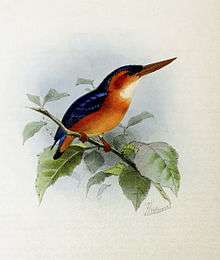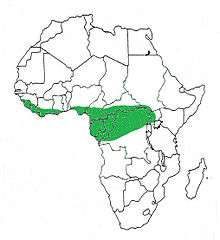African dwarf kingfisher
This article discusses the African dwarf kingfisher, which is distinct from the Oriental dwarf kingfisher.
| African dwarf kingfisher | |
|---|---|
 | |
| illustration by John Gerrard Keulemans | |
| Scientific classification | |
| Kingdom: | Animalia |
| Phylum: | Chordata |
| Class: | Aves |
| Order: | Coraciiformes |
| Family: | Alcedinidae |
| Subfamily: | Alcedininae |
| Genus: | Ispidina |
| Species: | I. lecontei |
| Binomial name | |
| Ispidina lecontei Cassin, 1856 | |
 | |
| Resident range | |
| Synonyms | |
| |
The African dwarf kingfisher (Ispidina lecontei) is a species of kingfisher in the Alcedininae subfamily.
Taxonomy
The African dwarf kingfisher was described in 1856 by the American ornithologist John Cassin from a specimen collected by Paul Du Chaillu. Cassin introduced the current binomial name Ispidina lecontei. The specific epithet was chosen in honour of the entomologist John Lawrence LeConte.[3]
There are two subspecies:[4]
Description
This is the world's smallest kingfisher with a length of 10 centimetres (3.9 in) and a weight of 9–12 grams (0.32–0.42 oz).[7]
Distribution
It inhabits African rainforests and is found in Angola, Cameroon, Central African Republic, Republic of the Congo, Democratic Republic of the Congo, Ivory Coast, Equatorial Guinea, Gabon, Ghana, Guinea, Liberia, Nigeria, Sierra Leone, South Sudan, and Uganda. [1]
References
- BirdLife International (2016). "Ispidina lecontei". IUCN Red List of Threatened Species. 2016. Retrieved 18 April 2019.CS1 maint: ref=harv (link)
- "Dwarf Kingfisher (Ceyx lecontei) (Cassin, 1856)". Biolib.cz. Retrieved December 22, 2012.
- Cassin, John (1856). "Descriptions of new species of African birds, in the Museum of Academy of Natural Sciences, of Philadelphia, collected by Mr. P.B. Du Chaillu, in Equatorial Africa". Proceedings of the Academy of Natural Sciences of Philadelphia. 8: 156–159 [158].
- Gill, Frank; Donsker, David, eds. (2017). "Rollers, ground rollers & kingfishers". World Bird List Version 7.2. International Ornithologists' Union. Retrieved 17 May 2017.
- https://www.birdguides.com/Species-Guide/ioc/ispidina-lecontei
- Dickerman, R.W. (1993). "On the validity of Ceyx (Myioceyx) lecontei ruficeps". Bulletin of the British Ornithologists' Club. 113 (4): 255–257.
- Fry, C. Hilary; Fry, Kathie; Harris, Alan (1992). Kingfishers, Bee-eaters, and Rollers. London: Christopher Helm. pp. 195–196. ISBN 978-0-7136-8028-7.
